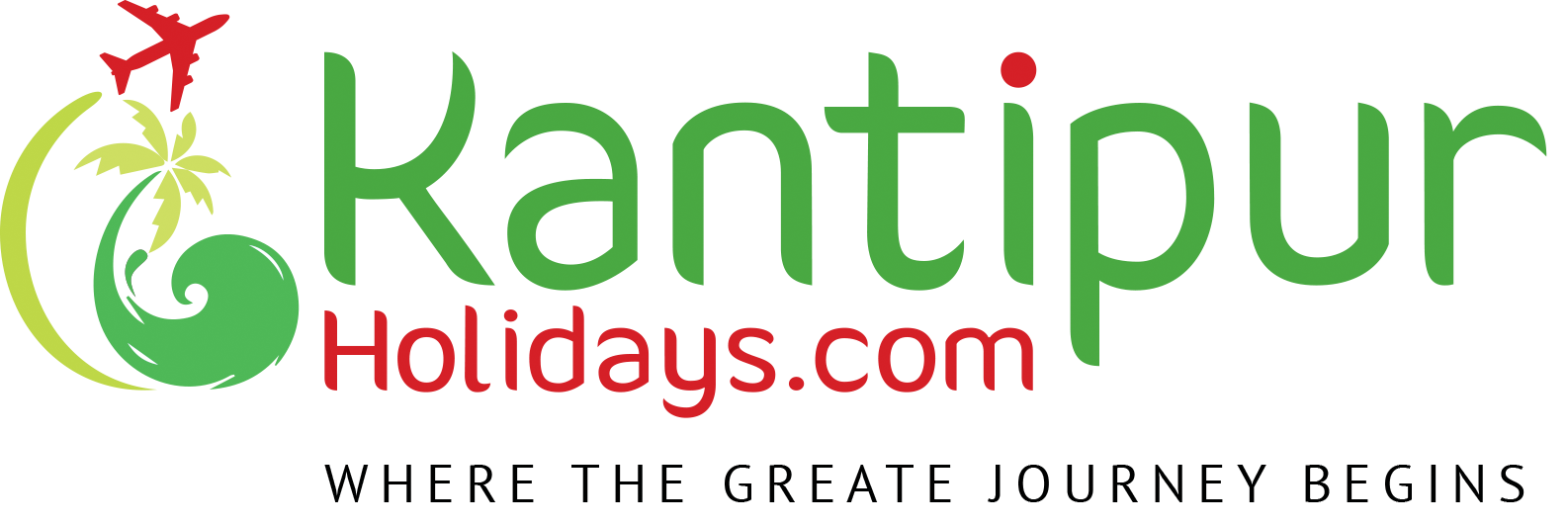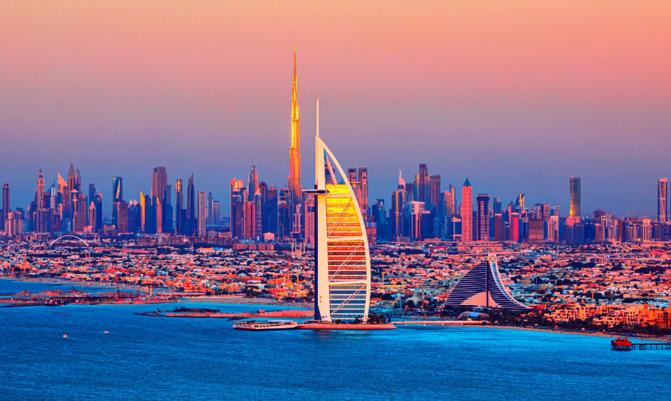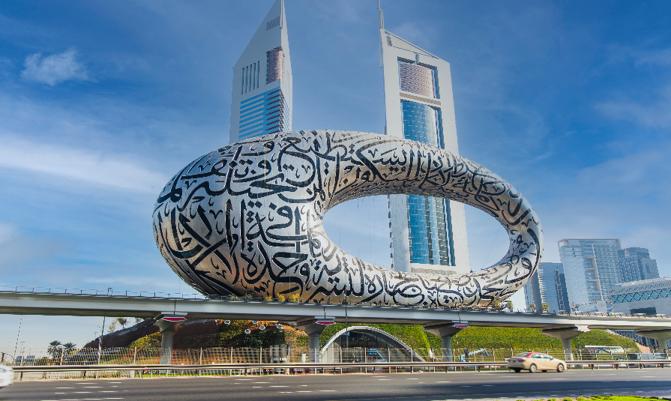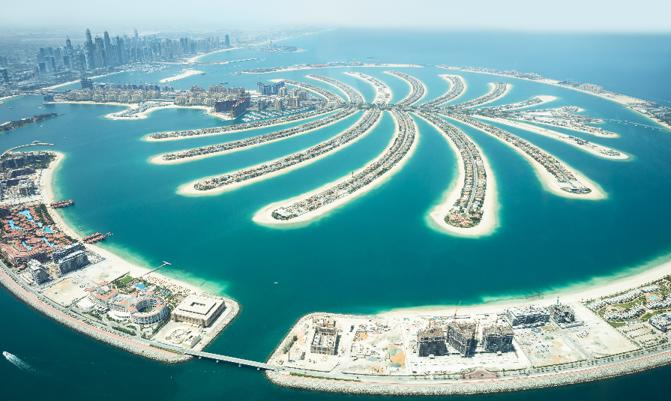Dubai
Dubai, also spelled Dubayy, city and capital of the emirate of Dubai, one of the wealthiest of the seven emirates that constitute the federation of the United Arab Emirates, which was created in 1971 following independence from Great Britain. There are several theories about the origin of the name Dubai. One associates it with the daba—a type of locust that infests the area—while another holds that it refers to a market that existed near the city. In recent years Dubai has been compared to Singapore and Hong Kong and is often regarded as the Middle East’s premier entrepôt. Area 13.5 square miles (35 square km). Pop. (2017 est.) 2,919,178.
Character of the city
Dubai is a city of skyscrapers, ports, and beaches, where big business takes place alongside sun-seeking tourism. Because of its large expatriate population, it feels like a Middle Eastern melting pot, and the atmosphere is generally tolerant. Religious affiliations are not a prominent aspect of city life. Islam is the majority religion, but churches and Hindu temples coexist with Dubai’s mosques.
Explore luxurious Dubai, the fastest-growing city in the world
Explore luxurious Dubai, the fastest-growing city in the worldSee all videos for this article
Dubai is a relatively crime-free place where administrative efficiency and openness to business have encouraged astounding growth. However, criticism of Dubai’s authoritarian government and ruling elite is not tolerated, and there persists an atmosphere of discreet corruption.
Landscape
The western area of Dubai benefits from small stretches of sandy beaches, which have helped to catalyze the city’s tourism industry. Dubai’s rulers have sought to increase the city’s limited seafronts, and, in the absence of natural offshore islands, developers were encouraged to construct giant man-made islands off the coast of the city. The most famous of these is Palm Jumeirah, which has the shape of a palm tree. Others include the “World” islands, a cluster of small islands positioned to resemble a world map when viewed from above.
City site and layout
Dubai straddles a natural inlet called Dubai Creek on the southern shores of the Persian Gulf. For more than a century, the area was Dubai’s centre, because of the early city’s reliance on fishing, pearl diving, and maritime trade. Lining the creek are the oldest buildings in Dubai, most of which date from the 1960s and are rarely more than two stories in height. In the Bastakiyyah quarter, on the western shore of the creek, some much older buildings have been restored, and many of these feature the distinctive wind tower design that was imported by Persian merchants early in the 20th century.
Burj Khalifa
The new city centre is a string of skyscrapers lining Sheikh Zayed Road. Notable among these are the Emirates Towers, which were built in the late 1990s and early 2000s and which house a hotel and government offices. Close to Sheikh Zayed Road is the Dubai International Financial Centre, housed in a futuristic arch-shaped building, and the Burj Khalifa, which at the time of its official opening in 2010 was the world’s tallest building; it was named after the president of the United Arab Emirates and emir of Abu Dhabi, Khalifa ibn Zayed Al Nahyan. To the west of the skyscrapers lie several affluent suburbs, most of which house substantial villas. On their periphery lies the Burj al-ʿArab, a giant sail-shaped tower which is home to a luxury hotel. Farther west are new clusters of skyscrapers surrounding a man-made marina and several man-made lakes.
Climate
Like much of the Persian Gulf coastline, Dubai has a year-round hot climate. Humidity is high in the summer months and moderate the rest of the year. The coldest winter month is usually January, with lows of about 15 °C (49 °F), while the hottest summer month is July, with highs of more than 40 °C (104 °F).
People
Dubai’s population has grown steadily over the past two centuries, from just a few thousand local inhabitants to well over two million. Most of the early population increases were due to merchants from neighbouring countries choosing to relocate to Dubai’s business-friendly environment. In the later 20th century the city’s construction boom led to a huge increase in the number of South Asian labourers and an influx of skilled expatriates from all over the world who play an important role in Dubai’s multi-sector economy. Expatriates in the city vastly outnumber native Emiratis. With the exception of the labourers, who are housed in work camps beyond the city limits, expatriates of various nationalities are spread across Dubai. Although Arabic is the official language, English is, in practice, the lingua franca.
The local population is predominately Muslim, and most of the expatriate population is also Muslim, although there are significant Christian, Hindu, and Sikh communities. Given the tolerance of the ruling family toward non-Muslims and the city’s focus on business, the various communities coexist harmoniously, although there have been occasions when foreign residents have broken decency codes or drug-use prohibitions.
Economy of Dubai
Contrary to popular belief, Dubai does not have an oil-based economy. The little oil wealth it did enjoy between the 1960s and the 1990s was used to enhance other sectors of its economy by building physical infrastructure. Trade remains at the core of Dubai’s economy, with the city operating two of the world’s largest ports and a busy international air cargo hub. The Jebel Ali free-trade zone was established in the 1980s to attract industrial investment; activities based there include aluminum smelting, car manufacturing, and cement production.
Finance and other services
In the 21st century, activities meant to attract foreign investment have increased. Several free zones, like Jebel Ali, have been established that allow foreign companies to operate from Dubai without needing a local partner. These have been phenomenally successful, with the largest being home to more than 6,400 companies, many of which are European or North American. In the 1990s the city began positioning itself as a luxury tourist destination, spending a significant percentage of its GDP on grandiose resorts and attractions.
By 1998 Dubai had begun to permit foreign investors to purchase 99-year leases on properties, allowing the real estate sector to flourish. The Dubai International Financial Centre, which opened in 2006, is set aside in the UAE constitution as an independent legal jurisdiction; it operates under a separate commercial and civil framework based on English common law. This arrangement caters to international financial companies seeking to establish a presence in the Middle East. These companies can use Dubai’s geographic location as a means to bridge the time zones between major financial hubs in Europe and East Asia. In 2009 the real estate and financial sectors crashed in the wake of the international credit crisis. A loan of $10 billion from Abu Dhabi helped Dubai avoid defaulting on its obligations, and the real estate market soon recovered.
Transportation
Take a ride on an ʿabra, a water taxi in Dubai
Take a ride on an ʿabra, a water taxi in DubaiSee all videos for this article
With wide highways, a hot climate, and a year-round reliance on air-conditioning, Dubai is not a welcoming city for pedestrians, so vehicle traffic can be extremely intense. However, in the early 21st century, new bridges, roads, and a fully automated, driverless metro rail system have eased the frustrations of moving around the city. Tourism has been greatly enhanced by the Dubai-owned airline, Emirates, which operates a large and modern fleet of aircraft.
Government
Dubai Municipality is one of the largest government institutions in the country. It is managed by a director general who in turn is accountable to the chairman of Dubai Municipality, a member of the ruling family. The director general oversees six sectors and 34 departments, which employ about 11,000 people. The municipality not only manages services in the city but is a key driver of economic growth in the emirate.
Municipal services
Dubai’s electricity and water provisions have largely kept up with the city’s population growth, though a number of other services such as waste collection have been criticized for falling behind. Parks and public spaces have been extensively developed and maintained; the city increased its number of green areas substantially in the 2010s.
Health
For those residents with private medical insurance, health care in Dubai is generally of a high standard, with several private hospitals, including the American Hospital Dubai. For those without insurance, the government operates a number of additional hospitals.
Education
Education is divided between the private and public sectors. Public school is generally taught in Arabic, while most private schools and all universities teach in English. Two universities, the American University in Dubai (1995) and Zayed University (1998), enjoy good reputations locally. Most of the staff are expatriates, with a significant proportion being from North America.
Cultural life
In the early 21st century, Dubai’s art and film industries blossomed, with the annual Art Dubai fair showcasing contemporary art and the Dubai International Film Festival promoting both local and international movies. The Dubai Museum, housed in an 18th-century fortress, displays artifacts and exhibits related to the area’s early history and traditional culture. Dubai’s public library system has several branches throughout the city, and there are a number of bookshops in the city’s shopping malls.
Dubai is home to a large number of international sporting events. These have greatly boosted its status as a tourist destination. The Dubai World Cup is the world’s most lucrative horse race, and the city’s Dubai Desert Classic is a popular fixture on the European Professional Golfers’ Association (PGA) Tour.
The city’s media industry remains firmly divided between government-backed television and newspapers, most of which are heavily censored, and the foreign media companies that operate branch offices from the Dubai Media City, a purpose-built complex that serves as an international media hub for the region. The latter include the BBC and the Associated Press, and their output does not have to conform to local restrictions.
History
From humble beginnings as a small fishing village first documented in the 18th century, the city grew rapidly as it became a major centre of the pearl-diving industry. With its business-savvy ruling family reducing taxes and welcoming foreign merchants, the city expanded further in the early 20th century and soon became a re-exporting hub for Persia and India. Benefiting from modest oil wealth in the latter half of the 20th century, Dubai continued to focus on trade and attracting investment, channelling oil surpluses into major infrastructure projects such as an international airport, dry docks, and a trade centre. In the 1990s the city began to diversify, building up its luxury tourism, real estate, and financial sectors. These all required skilled, educated foreign workers, and many moved to Dubai for its tax-free salaries and relatively stable politics. With expatriates coming from elsewhere in the Arab world as well as from Asia, Europe, and North America, the city took on a rather cosmopolitan air and was considered to have one of the most liberal societies in the region.



